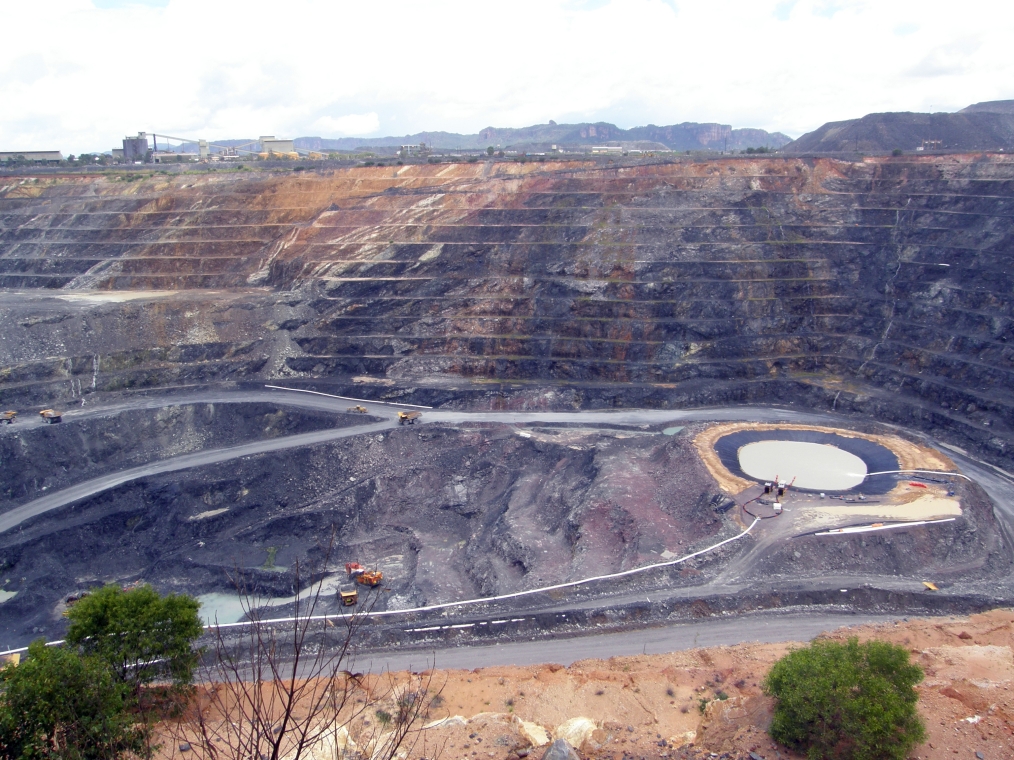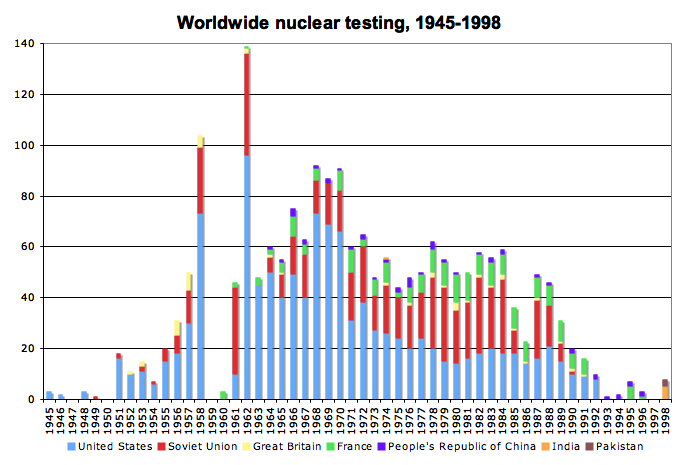|
World Uranium Hearing
The World Uranium Hearing was held in Salzburg, Austria in September 1992. Anti-nuclear speakers from all continents, including indigenous speakers and scientists, testified to the health and environmental problems of uranium mining and processing, nuclear power, nuclear weapons, nuclear tests, and radioactive waste disposal. People who spoke at the 1992 Hearing include: Thomas Banyacya, Katsumi Furitsu, Manuel Pino and Floyd Red Crow Westerman. They said they were deeply dismayed by the atomic bombings of Hiroshima and Nagasaki and highlighted what they called the inherently destructive nature of all phases of the nuclear supply chain. They recalled the disastrous impact of nuclear weapons testing in places such as the Nevada Test Site, Bikini Atoll and Eniwetok, Tahiti, Maralinga, and Central Asia. They highlighted the threat of radioactive contamination to all peoples, especially indigenous communities and said that their survival requires self-determination and emphasis on ... [...More Info...] [...Related Items...] OR: [Wikipedia] [Google] [Baidu] |
Salzburg, Austria
Salzburg (, ; literally "Salt-Castle"; bar, Soizbuag, label=Bavarian language, Austro-Bavarian) is the List of cities and towns in Austria, fourth-largest city in Austria. In 2020, it had a population of 156,872. The town is on the site of the Roman settlement of ''Iuvavum''. Salzburg was founded as an episcopal see in 696 and became a Prince-Archbishopric of Salzburg, seat of the archbishop in 798. Its main sources of income were salt extraction, trade, and gold mining. The fortress of Hohensalzburg Fortress, Hohensalzburg, one of the largest medieval fortresses in Europe, dates from the 11th century. In the 17th century, Salzburg became a center of the Counter-Reformation, with monasteries and numerous Baroque churches built. Historic Centre of the City of Salzburg, Salzburg's historic center (German language, German: ''Altstadt'') is renowned for its Baroque architecture and is one of the best-preserved city centers north of the Alps. The historic center was enlisted as a UN ... [...More Info...] [...Related Items...] OR: [Wikipedia] [Google] [Baidu] |
Maralinga
Maralinga, in the remote western areas of South Australia, was the site, measuring about in area, of British nuclear tests in the mid-1950s. In January 1985 native title was granted to the Maralinga Tjarutja, a southern Pitjantjatjara Aboriginal Australian people, over some land, but around the same time, the McClelland Royal Commission identified significant residual nuclear contamination at some sites. Under an agreement between the governments of the United Kingdom and Australia, efforts were made to clean up the site before the Maralinga people resettled on the land in 1995. The main community, which includes a school, is Oak Valley. There are still concerns that some of the ground is still contaminated, despite two attempts at cleanup. History Nuclear tests and cleanup Maralinga was the scene of UK nuclear testing and was contaminated with radioactive waste in the 1950s and early 1960s. Maralinga was surveyed by Len Beadell in the early 1950s. It followed the survey ... [...More Info...] [...Related Items...] OR: [Wikipedia] [Google] [Baidu] |
Radiobiology
Radiobiology (also known as radiation biology, and uncommonly as actinobiology) is a field of clinical and basic medical sciences that involves the study of the action of ionizing radiation on living things, especially health effects of radiation. Ionizing radiation is generally harmful and potentially lethal to living things but can have health benefits in radiation therapy for the treatment of cancer and thyrotoxicosis. Its most common impact is the induction of cancer with a latent period of years or decades after exposure. High doses can cause visually dramatic radiation burns, and/or rapid fatality through acute radiation syndrome. Controlled doses are used for medical imaging and radiotherapy. Health effects In general, ionizing radiation is harmful and potentially lethal to living beings but can have health benefits in radiation therapy for the treatment of cancer and thyrotoxicosis. Most adverse health effects of radiation exposure may be grouped in two general categori ... [...More Info...] [...Related Items...] OR: [Wikipedia] [Google] [Baidu] |
Nuclear Technology
Nuclear technology is technology that involves the nuclear reactions of atomic nuclei. Among the notable nuclear technologies are nuclear reactors, nuclear medicine and nuclear weapons. It is also used, among other things, in smoke detectors and gun sights. History and scientific background Discovery The vast majority of common, natural phenomena on Earth only involve gravity and electromagnetism, and not nuclear reactions. This is because atomic nuclei are generally kept apart because they contain positive electrical charges and therefore repel each other. In 1896, Henri Becquerel was investigating phosphorescence in uranium salts when he discovered a new phenomenon which came to be called radioactivity. He, Pierre Curie and Marie Curie began investigating the phenomenon. In the process, they isolated the element radium, which is highly radioactive. They discovered that radioactive materials produce intense, penetrating rays of three distinct sorts, which they labeled al ... [...More Info...] [...Related Items...] OR: [Wikipedia] [Google] [Baidu] |
Hibakusha
''Hibakusha'' ( or ; ja, 被爆者 or ; "person affected by a bomb" or "person affected by exposure o radioactivity) is a word of Japanese origin generally designating the people affected by the atomic bombings of Hiroshima and Nagasaki at the end of World War II. Definition The word ''hibakusha'' is Japanese, originally written in kanji. While the term Hibakusha (''hi'' "affected" + ''baku'' "bomb" + ''sha'' "person") has been used before in Japanese to designate any victim of bombs, its worldwide democratisation led to a definition concerning the survivors of the atomic bombs dropped in Japan by the United States Army Air Forces on the 6 and 9 August 1945. Anti-nuclear movements and associations, among others of ''hibakusha'', spread the term to designate any direct victim of nuclear disaster, including the ones of the nuclear plant in Fukushima. They therefore prefer the writing (substituting ''baku'' with the homophonous "exposition") or "person affected by the ex ... [...More Info...] [...Related Items...] OR: [Wikipedia] [Google] [Baidu] |
List Of Nuclear-Free Future Award Recipients
Since 1998 the Nuclear-Free Future Award (NFFA) is an award given to anti-nuclear activists, organizations and communities. The award is intended to promote opposition to uranium mining, nuclear weapons and nuclear power. The NFFA is a project of the Franz Moll Foundation for the Coming Generations and gives out awards in three categories: Resistance ($10,000 prize), Education ($10,000 prize) and Solutions ($10,000 prize). Additional optional categories are Lifetime Achievement and Special Recognition (contemporary work of art). The award ceremonies take place all around the world. The NFFA is financed by donations, charity events, and benefit auctions. Laureates The Nuclear-Free Future Award Laureates: See also * List of nuclear whistleblowers * List of peace activists * William and Katherine Estes Award * Non-nuclear future * Nuclear Free World Policy * World Uranium Hearing * Anti-nuclear movement * Nuclear disarmament * List of environmental awards This list of enviro ... [...More Info...] [...Related Items...] OR: [Wikipedia] [Google] [Baidu] |
Uranium Mining Debate
The uranium mining debate covers the political and environmental controversies of uranium mining for use in either nuclear power or nuclear weapons. Background and public debate As of 2009, in terms of uranium production, Kazakhstan was the largest supplier to export markets (27%), followed by Canada (20%) and Australia (16%). Australia has 23% of the world's uranium ore reserves and the world's largest single uranium deposit, located at the Olympic Dam Mine in South Australia. The years 1976 and 1977 saw uranium mining become a major political issue in Australia, with the Ranger Inquiry (Fox) report opening up a public debate about uranium mining.Bauer, Martin (ed) (1995). ''Resistance to New Technology'', Cambridge University Press, p. 173. The Movement Against Uranium Mining group was formed in 1976, and many protests and demonstrations against uranium mining were held.Drew Hutton and Libby Connors, (1999). ''A History of the Australian Environmental Movement'', Cambrid ... [...More Info...] [...Related Items...] OR: [Wikipedia] [Google] [Baidu] |
The Navajo People And Uranium Mining
''The Navajo People and Uranium Mining'' (2006) is a non-fiction book edited by Doug Brugge, Timothy Benally, and Esther Yazzie-Lewis; it uses oral histories to tell the stories of Navajo Nation families and miners in the uranium mining industry. The foreword is written by Stewart L. Udall, former U.S. Secretary of the Interior. ''The Navajo People and Uranium Mining'' has 12 chapters. Seven chapters contain stories of the Navajo told through interviews of the miners or their families. The remaining chapters describe the health effects related to uranium mining, and "how these medical issues adversely affected the lives of the miners and their families". '' |
History Of The Anti-nuclear Movement
The application of nuclear technology, both as a source of energy and as an instrument of war, has been controversial.Robert BenfordThe Anti-nuclear Movement (book review)''American Journal of Sociology'', Vol. 89, No. 6, (May 1984), pp. 1456-1458. Scientists and diplomats have debated nuclear weapons policy since before the atomic bombing of Hiroshima in 1945. The public became concerned about nuclear weapons testing from about 1954, following extensive nuclear testing in the Pacific. In 1961, at the height of the Cold War, about 50,000 women brought together by Women Strike for Peace marched in 60 cities in the United States to demonstrate against nuclear weapons. In 1963, many countries ratified the Partial Test Ban Treaty which prohibited atmospheric nuclear testing. Some local opposition to nuclear power emerged in the early 1960s,Paula Garb Review of Critical Masses ''Journal of Political Ecology'', Vol 6, 1999. and in the late 1960s some members of the scientific co ... [...More Info...] [...Related Items...] OR: [Wikipedia] [Google] [Baidu] |
Uranium In The Environment
Uranium in the environment refers to the science of the sources, environmental behaviour, and effects of uranium on humans and other animals. Uranium is weakly radioactive and remains so because of its long physical half-life (4.468 billion years for uranium-238). The biological half-life (the average time it takes for the human body to eliminate half the amount in the body) for uranium is about 15 days. Normal functioning of the kidney, brain, liver, heart, and numerous other systems can be affected by uranium exposure, because uranium is a toxic metal. The use of depleted uranium (DU) in munitions is controversial because of questions about potential long-term health effects. Natural occurrence Uranium is a naturally occurring element found in low levels within all rock, soil, and water. This is the highest-numbered element to be found naturally in significant quantities on earth. According to the United Nations Scientific Committee on the Effects of Atomic Radiation the nor ... [...More Info...] [...Related Items...] OR: [Wikipedia] [Google] [Baidu] |
International Uranium Film Festival
The International Uranium Film Festival was founded in 2010 in Rio de Janeiro, and has traveled to Germany, Portugal, India and the United States. This educational event merges art, ecology, environmentalism and environmental justice, to inform the public about uranium mining and milling, nuclear power issues, nuclear weapons and the nuclear fuel cycle from "cradle to grave" life-cycle assessment - and the effects of radioactivity on humans and other species. The festival founders and principal organizers are Norbert Suchanek and Marcia Gomes de Oliveira. The legal organizer of the International Uranium Film Festival is the arts and education non-profit "Yellow Archives". The organizers and the festival participants seek to educate and activate the international public on these issues through the dynamic media of film and video. Film themes The films shown typically have content that critiques and analyzes uranium mining, milling, and use, and the effects there of on land, water ... [...More Info...] [...Related Items...] OR: [Wikipedia] [Google] [Baidu] |






